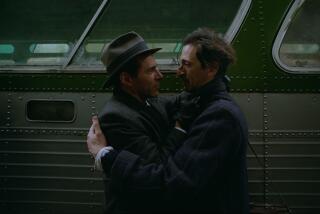Fascinating ‘Cinema Europe’ Brings Film History to Life
- Share via
Kevin Brownlow and David Gill’s “Cinema Europe: The Other Hollywood” is an enthralling and perceptive six-hour, six-part survey of key Western European national cinemas from their inception to the advent of sound.
Their prodigious research, peerless scholarship, inspired interweaving of film clips, interviews, newsreels and stills and, above all, astute and careful judgments combine to create a totally captivating experience that will be a revelation to cineastes and general audiences alike.
Place “Cinema Europe” alongside Brownlow and Gill’s “Hollywood: The Pioneers” and “The Unknown Chaplin” and you have the finest introduction to the glories of the silent cinema ever made. It’s impossible to imagine any other examples of such superb and comprehensive scholarship being so thoroughly fascinating and entertaining.
The series is being given its U.S. premiere this week on cable’s Turner Classic Movies channel, with Part 1 (“Where It All Began”) and Part 2 (“Art’s Promised Land”) airing from 5 to 7 p.m. and again from 9 to 11 p.m. today and the other hourlong installments following Tuesday through Friday at 5 and 8 p.m. Each part will be followed by a vintage full-length feature film. The series will be released on home video later this year.
Brownlow and Gill deftly take us through the beginning of the exhibition of films as they moved out of arcade machines to the screen. They shift from country to country, commencing with the Dec. 28, 1895, presentation in Paris of an evening of short film by the brothers Lumiere, who thought they had come up with a novelty with perhaps a life span of six months but instead launched the art form of the 20th century.
Brownlow and Gill capture that early excitement created by brief home movies and newsreels, from which many began to see fictional narrative possibilities--among them George Melies, whose whimsical fantasies retain their lacy valentine charm.
The filmmakers pay homage to the early cinema in Scandinavia, where film was seen as a potential art form early on and which contributed the first European star: the sultry, versatile Dane Asta Nielsen, whose naturalistic acting style became typical. They concentrate on two giants: actor-director Victor Sjostrom, who made what is arguably the cinema’s first masterpiece, the socially conscious “Ingebord Holm” (1913), and director Mauritz Stiller, who discovered Greta Garbo.
Meanwhile, Italy became preeminent in the historical spectacle, most notably with “Cabiria” (1913), which inspired D.W. Griffith to make “Intolerance” (1916).
Nevertheless, as the decade wore on, France would emerge dominant, with its mix of strong realistic dramas and popular serials and the emergence of the elegant comedian Max Linder, a key influence upon Chaplin.
Brownlow and Gill point out that Britain, where lively experimentation had taken place during the century’s first decade, lost out in the battle for preeminence in European cinema through a combination of snobbery and Hollywood block-booking policies. They single out a handful of venturesome films made in the ‘20s; ironically, they are the least familiar, apart from Hitchcock’s earliest pictures, in the entire survey.
*
The best-known films in “Cinema Europe” are those of Germany’s Golden Age of the ‘20s, and the way in which Brownlow and Gill regard them attest to their astuteness. For example, in examining the Expressionist style, they show how it evolved from a matter of set design to light and shadow.
Similarly, in covering the French films of the same decade, they single out the bravura accomplishments of Abel Gance, first in his train melodrama “La Roue” (1922), pointing out that his rapid cutting preceded the fabled montages of the Russians, and then in “Napoleon” (1927), which they restored. They show the crucial role of a previously unheralded camera assistant and a mechanical genius, Simon Feldman, interviewed at age 103, in making possible that epic’s innovative uses of the camera.
While never forgetting the volatile interacting forces of politics and economics in shaping the history of the cinema, Brownlow and Gill, in dealing with the advent of sound, continue their detective work. They show us how Hitchcock, ordered to turn just the last part of “Blackmail” (1929) into a talkie, secretly adapted it entirely to sound, creating Britain’s first talking picture.
Having shown how effectively the British and the Germans collaborated on the making of “Atlantic” (1930), about the sinking of the Titanic, Brownlow and Gill declare decisively that the rise of Hitler and the establishment of the Third Reich destroyed all hopes of establishing a true Euro-Hollywood.
“Cinema Europe” has been superbly scored by Nic Raine with title music by Carl Davis, the premiere composer for silent films, and it has been narrated by Kenneth Branagh in a warm conversational tone.
* “Cinema Europe: The Other Hollywood” airs Monday through Friday at 5 p.m., with repeats at 9 tonight and 8 p.m. the rest of the week on Turner Classic Movies. The cable channel also will show the series in its entirety from 9 a.m to 3 p.m. Sunday.
More to Read
Only good movies
Get the Indie Focus newsletter, Mark Olsen's weekly guide to the world of cinema.
You may occasionally receive promotional content from the Los Angeles Times.










